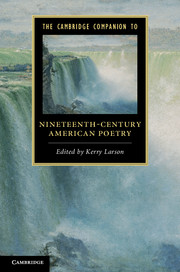Book contents
- Frontmatter
- Introduction
- I MANDATES, MOVEMENTS, AND MANIFESTOES
- 1 The reception of nineteenth-century American poetry
- 2 American Indian poetry in the nineteenth century
- 3 The poet as Poetess
- 4 Transcendentalist poetics
- 5 Slavery and its metrics
- 6 Weathering the news in US Civil War poetry
- 7 The “Twilight of the Poets” in the era of American realism, 1875–1900
- II INDIVIDUAL AUTHORS
- Selected guide to further reading
- Index
- Cambridge Companions to…
6 - Weathering the news in US Civil War poetry
from I - MANDATES, MOVEMENTS, AND MANIFESTOES
Published online by Cambridge University Press: 28 November 2011
- Frontmatter
- Introduction
- I MANDATES, MOVEMENTS, AND MANIFESTOES
- 1 The reception of nineteenth-century American poetry
- 2 American Indian poetry in the nineteenth century
- 3 The poet as Poetess
- 4 Transcendentalist poetics
- 5 Slavery and its metrics
- 6 Weathering the news in US Civil War poetry
- 7 The “Twilight of the Poets” in the era of American realism, 1875–1900
- II INDIVIDUAL AUTHORS
- Selected guide to further reading
- Index
- Cambridge Companions to…
Summary
The outpouring of poetry in newspapers and magazines, North and South, during the Civil War period, served the wartime work of calling men to arms, offering solace for those who lost loved ones in battle, and justifying blood sacrifice in the name of patriotism. Precisely when the constitution of nations was at stake, writers and readers believed that poetry's communicative powers could both express and shape national beliefs and sentiments. Poetry's communicative powers depended not just on its internal formal and rhetorical properties, but also on the vast informational network that served the conflict and helped determine its outcomes; especially in the North, telegraph, railroad, newspapers, and magazines consolidated into a mass media system that drew its energy from the war. The hunger for information fueled a new profession: the eyewitness reporter sent in sketches or stories composed at the site of events unfolding. Railroad and telegraph transmission enabled people far away from the action to receive reports with an astonishing rapidity that caused a newly intense addiction to the news; people needed only “bread and newspaper,” according to Oliver Wendell Holmes, Sr. Newspapers like Harper's Illustrated Weekly, Frank Leslie's Illustrated Weekly, and Southern Illustrated Weekly fed that addiction, carrying poetry alongside journalistic reportage and illustrations. These communicative modes or genres were by no means separate; each informed the other.
- Type
- Chapter
- Information
- The Cambridge Companion to Nineteenth-Century American Poetry , pp. 113 - 134Publisher: Cambridge University PressPrint publication year: 2011
- 2
- Cited by



